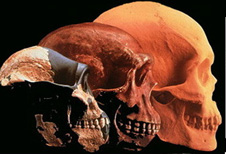
Mammals.
Mountain-Folding and Global Cooling...
Timeline 5 - 70 million years ago to present
www.fsnielsen.com - return to graphic - previous - next -
We have passed the famous K-2 boundary, the last great mass extinction, in which the age of dinosaurs came to an end, and the age of mammals commenced. We now catch the first glimpses of the earth as we know it.
The K-2 boundary itself has been drawn on the timeline as a 5 million year long black line, though in fact the catastrophe may have been quite sudden (meteorite impact). But even if the event itself was brief, its aftermath must have been long. These were major extinctions (smaller ones are more common), in which tens of thousands of species completely died out. In evolutionary terms, an extinction leaves a (more or less) "blank slate" for the surviving species. Mammals, who were small, furtive and marginal during the late Mesozoic, suddenly stepped out from under, and inside of 5-10 million years had diversified and spread to every corner of the earth.
Primates, the distant relatives of homo sapiens, have their origin at this time. Primates are mostly tree-dwellers, with elastic build, good eyesight and grasping digits on all four feet. They are omnivores, and quickly took to developing above-average sized brains, and with the great mountain foldings and the increasingly cold climate, the evolutionary demand for large brains was growing, as the below graph of growing brain sizes during the last 200 million years, and the image of superimposed human and pre-human skulls, demonstrates:

Evolution of primate and human brain size
- note the speed at which the brain has evolved during the last 40-60 million
years - the period of mountain folding and more and more intensive glaciation.
Source: http://serendip.brynmawr.edu/bb/brainevolution/brainevol3.html

Evolution of human brain: Australopithecus
afarensis, Homo erectus, Homo sapiens
Source: http://www.wsu.edu:8001/vwsu/gened/learn-modules/top_longfor/phychar/culture-humans-2two.html
Sources:
Formation of E. Antarctic Ice Shelf; Separation of Antarctica from S. America: Scientific American February 2008, p.55.